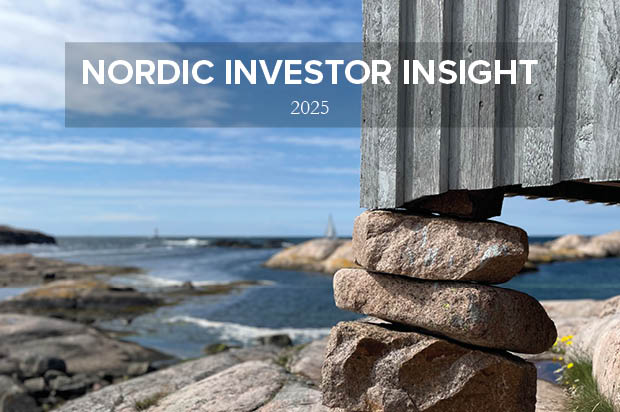
Short-term challenges in a good long-term environment
In a discussion earlier this spring with the infrastructure specialist Morrison and Swedish manager selectors, some of the topics covered were key similarities and differences between listed and unlisted infrastructure investments, return expectations and the general outlook for infrastructure.
The discussion kicked off with a question related to the definition of infrastructure as the answer may differ.
Tim Skerman: “There's no public market asset class definition, so each person needs to define that. We also think that some of the indices are poorly defined. As a specialist focused on infrastructure, we like to look really broad in order to assess individual opportunities that fit with the overall thematic drivers that we've identified.”
Maria Wendestam: “So you are not limited by an index but instead create your own universe?”
Tim Skerman: “As we define the universe, we will look at around 700 stocks that would fit somewhere into infrastructure and then we’re drilling down from there in order find an overlap between these infrastructure characteristics as well as our thematic drivers.”
Niklas Tell: Would you say that the definition is different between public and private infrastructure and has this shifted over time?
Tim Skerman: “They are slightly different. Not so much in terms of the underlying asset itself but sometimes when we put the public market lens over the top of it, we're not necessarily getting the same characteristics coming through. The healthcare infrastructure space is a really good example of that. We might find a hospital or healthcare business that are very infrastructure-like, but by the time you put them in a public equities context, they don't trade anything like infrastructure.”
Stephen Jordan: “Also, it’s a continually evolving sector. If you go back 10 or 15 years, you didn’t have data centres and offshore wind wasn't around 15 years ago. If you think about infrastructure as something that will support society in the future, you will have to keep on looking and keep on refining it to understand if the infrastructure characteristics are there and if those characteristics will show up in the listed market.”
Julia Axelsson: “You mentioned that you're not very happy with current indices. What's the problem and where are the biggest differences compared to how you define your universe?”
Tim Skerman: “First of all, it’s of course interesting that they're all different, so the index providers are also struggling to define infrastructure. When we look at some indices, they're very heavily commodity-related and that makes it difficult to isolate the commodity risk. Others exclude fairly substantial groups of assets that we would consider infrastructure. Because there isn't a classification, you will be underrepresented or overrepresented in certain places.”
Maria Wendestam: “What about the boundary between infrastructure and real estate? We’ve talked about data centres for example.”
Tim Skerman: “Property is a core part of infrastructure because you're an actual owner of it. If you look at an airport, for example, the airport typically has strategic land holdings around the airport to facilitate growth. Quite often as an industry or a sub-sector of infrastructure matures, you will get this separation between the mature cash-yielding infrastructure and the development vehicle.”
Julia Axelsson: “Coming back to the investment universe – what segments do you focus on?”
Tim Skerman: “We try to break it down by thematics, but everything of course needs to fit the criteria for infrastructure as well. Some of the key themes that we will look at include mobility where you find traditional infrastructure like airports, roads and railways. Another segment is decarbonisation, which is partly energy transition-related and we also look at circular economy-related investments. These typically relate to waste and waste flows. These investments very much depend on the [business model in each] country as we want to ensure that we get inflation passed through.”
Stephen Jordan: “Probably the most rapidly changing part of infrastructure is the digital and connectivity sector. That moved from cell towers to data centres and into fibre connectivity to support society. We also have satellite operators as well that sometimes have infrastructure characteristics.”
Niklas Tell: What are some of the biggest differences when it comes to accessing different types of infrastructure with regards to the public and private part of the market?
Stephen Jordan: “One of the differences is the scale that some of the listed companies have. If you think about some of the utilities in the US and some of the big data centre companies, these are relatively large companies and that will have an impact on the business model. There are some business models that are only available to public markets.”
Tim Skerman: “I think that the two can be quite complementary if you're looking to get exposure to infrastructure. There are certain parts that you couldn't get on the private side because things like scale, as Stephen said, and there are things that you couldn't get on the listed side because they're just starting to develop, like we're seeing [regionally] in the data centre market at the moment.”
Julia Axelsson: “So how would listed infrastructure compare to private market infrastructure in general?”
Tim Skerman: “The underlying assets are pretty similar but we do of course notice variations over time when it comes to the pricing difference between listed and unlisted. A great example is the renewable space right now, where we've seen a number of assets being privatised in Europe. If you went back to 2020, you saw the opposite with a lot of IPO activity with private equity exits in the public markets.”
Stephen Jordan: “In public markets, we of course need to be aware that the value we see in the underlying asset might not be reflected in the equity price path. That's a different risk that you are taking on by making that investment in listed infrastructure.”
Maria Wendestam: “I can relate to that. In our portfolios, we have one listed energy transition fund and a semi-liquid energy transition fund in the alternative space and they've been moving in different directions. The managers for the listed funds say that they’ve seen a number of their holdings being taken private and says that the private market knows how to value these companies. On another note, do you get the inflation hedge when you invest in listed infrastructure?”
Tim Skerman: “You certainly do at the asset level. It becomes a bit more complex when you put this into the public market context. If you look at the data for infrastructure over a long period of time and map the movement of public equity against private equity, what you find is public infrastructure equities overlay private valuations within a band of shorter-term volatility. Renewables is a good example. It went from the top end of that volatility [range] early in 2021 to the bottom now, but the value of the assets is moving in the same direction. Even though you're in a market where you have daily liquidity, you will follow the same path over a longer-term horizon.”
Julia Axelsson: “Is there an illiquidity premium to be collected when it comes to public infrastructure?”
Tim Skerman: “The way I would think about it is that when we purchase an asset as an unlisted holding, we try to buy it at a discount and ideally, we will be looking at bilateral transactions to achieve that. If you’re in an auction process, you would probably say that you paid a fair price. So the starting point would be that an unlisted asset is acquired at fair price and you will add value to that asset over time. There's a control value to that that you don't have as an owner of one share in a listed company. What you do get as an owner of one share in a listed market is to choose the point at which you're entering that investment. And ideally, we’re able to buy at a discount to the fair value. That's how I would think about that premium.”
Niklas Tell: How should investors evaluate a listed infrastructure fund? I would guess it’s both about the fund manager but also about understanding when to make an investment as you would like to enter when the public market undervalues the underlying assets.
Tim Skerman: “Because it's all we do every day, I think we’re able to see the value change within the sub-sectors of infrastructure. We focus on which parts of infrastructure that are interesting right now and less about whether infrastructure is cheap or expensive relative to everything else. From the investor perspective, I think it's quite difficult to make that assessment because it's really hard to get the granularity that we have every day between different sub-sectors. One interesting observation, particularly with regards to the growth in AI and data centres, is how careful utilities are with regards to their public guidance. We expect this to be driving earnings growth and earnings per share growth, which will be rewarded by equity markets.”
Julia Axelsson: “It wasn’t too long ago we had the DeepSeek moment, which caused a bit of a scare for the sector. I can see why they're conservative in their estimates because you don't even know how much of this infrastructure that you're building now is going to be utilised eventually.”
Stephen Jordan: “They also have a responsibility as a utility to multiple stakeholders to ensure that enough power is available. It's not as simple as just plug and play.”
Tim Skerman: “I think the DeepSeek moment was a really good reality check for the market, because to that point everyone had been very focused on the vast sums of money being invested by the magnificent seven and others across the market. This was a realisation that there might be some different pathways forward here. One of the takeaways that we had from that moment was to consider how these large language learning models move from training to becoming available. We're not expecting a change in that long-term thematic for data growth, but we need to consider the change that’s happening and how we want to be positioned in assets that are well placed to be enabling that but also commercially benefiting from that.”
Maria Wendestam: “I assume it will be more local going forward?”
Tim Skerman: “There’s a lot of statistics out there. Some of them real and some that can be best described as guesswork about what happens next, for example, when you change your habit from a Google search to a more complex AI question. It has a real-world implication for the amount of power that it takes, so there are a whole lot of questions about latency – where the data centre is and how it is hosted. Then of course we have another layer of debate as well related to geopolitical considerations.”
Julia Axelsson: “We touched on timing earlier and obviously timing is difficult, but how much attention do you pay to the global macro environment in your investment?”
Tim Skerman: “Macro inputs feed our long-term valuation models. We're very much bottom-up led, but we do look at the macro environment, particularly at the moment where we're getting so much uncertainty.”
Niklas Tell: How big of a risk or opportunity is this current geopolitical uncertainty when it comes to infrastructure assets?
Tim Skerman: “I think it can be both. The increase in defence spending in Europe may likely prove to be a good thing for European satellite companies for example. If we go back to data, for a long time we didn’t have to think about where our data was actually sitting in the world. I think increasingly that’s going to change and I would expect there to be a conversation in Europe about where the data sits and how we can access it. It becomes a matter of national security and protection as well. What does that mean for infrastructure? It would be reasonable to conclude that it could mean regionalisation of some of these assets.”
Niklas Tell: I assume that’s not necessarily a bad thing because a lot of the infrastructure is fairly local or regional anyway.
Tim Skerman: “If you have a wind farm somewhere in the countryside here, it's not really affected by deglobalisation. It’s more of a discussion when it comes to data centres. If we go back to moving from training to using large language models, do you need to physically move the model or are you shipping the data? Where does that sit, where is it hosted and who are the cloud providers? Right now, it’s all Meta, Google and AWS. What will the European solution be for that?”
Maria Wendestam: “How do you view the fiscal stimulus in Germany? Does that make Europe more interesting for you now?
Stephen Jordan: “I think a lot of economies are looking to support growth and a lot of that relates to infrastructure so from that perspective it can be quite exciting. However, we must also remember that there can be a disconnect between what is said and what actually transpires.”
Tim Skerman: “There's also a question as to the role of the state and what role private markets should have.”
Julia Axelsson: “You include emerging markets in your available universe. What are you seeing and how do you view the political risks?”
Tim Skerman: “As a specialist, we feel like we can look at all markets but we're very conscious of where we identify value. In emerging markets, we want to understand that we're investing in the infrastructure excess return opportunity and we tend to find assets that are helping the countries rather than essential services. An airport is generating tourism and inbound flow and it's not demanding government spending and it’s not related to the underlying population like waste collection or tap water services. We want to have a clear line of sight to the infrastructure. For our fund, we have a cap that says that we can’t invest more than 20 per cent in emerging markets and we can’t hold more than 10 per cent in any one individual emerging market country.”
Julia Axelsson: “You’re running this as an Article 8 fund. What does that mean for you from a sustainability point of view and how do you monitor the carbon footprint of your portfolio?”
Tim Skerman: “Our overall business purposes is to invest wisely in ideas that matter so that’s how we approach this. How are we finding things that matter to society and how does that materialise in practise for us in our investment process? First, we positively screen things into our universe and then we will do a sustainability risk review which consists of an ESG review as well as a carbon element. We strive to be transparent in the way that we're constructing and including some of these risks in our portfolio.”
Julia Axelsson: “Building infrastructure is intrinsically a carbon-intense process. How do you ensure that the portfolio is on the right path towards net zero? Is it about shifting the portfolio or is your focus on the transitioning of the companies themselves?
Tim Skerman: “It’s very much about assessing each individual asset and their journey. If we're investing on the basis of decarbonisation, we don't want to look just at the portfolio level. We want to understand what those individual assets are doing to demonstrate that they are achieving their targets.”
Stephen Jordan: “What’s important is building conviction that the company team that you're investing in are truly committed to what they say they are doing with regards to their transition path and plan. We will do that assessment upfront but then it’s very much about following up.”
Julia Axelsson: “You depend on public data and companies being transparent when it comes to your work on sustainability. Are you anticipating any fallout when it comes to this because of the backlash we see in the US?”
Stephen Jordan: “The underlying data is still available. What has changed is how companies are communicating that data to the market. I think they're being more cautious on how much they're promoting this.”
Niklas Tell: What should investors expect to receive in terms of returns from infrastructure – both private markets and listed infrastructure?
Tim Skerman: “I think you need to apply two contextual lenses in order to answer that question. First is of course the type of asset that you're looking at because the returns will be very different. If you have a contracted regulated core infrastructure asset, I think it’s fair to say that represents a lower risk and lower return opportunity. At the other end of the spectrum, you have assets that are new developments or where there are additional risks associated with the asset. However, there’s also an additional dimension to consider when you put this in a public market context. The second consideration is the time horizon and it would be a fair assumption that the difference between listed and unlisted shrinks over time. Our job in public markets is to try to understand when things are cheap and build the portfolio in that direction. The return from a typical index over a 10-year horizon is somewhere around 8 to 9 per cent. We’ve been running our portfolio for 15 years and we’ve been able to generate more than that.”
Niklas Tell: How would you describe the general outlook for infrastructure given where we are right now?
Tim Skerman: “I would say there are some really strong thematic tailwinds in our sector at the moment, such as data growth and the energy transition. They’re not new in terms of thematics, but they are really developing quickly from an infrastructure perspective. That of course provide opportunities for infrastructure specialists to analyse and understand where you're going to be well positioned for those changes. In the face of that, you obviously have some question marks over the current development in the US and potential changes in the macro environment. Are we in a recessionary environment? Will we have rate cuts? To me, they’re all really interesting in how we manage the portfolio, but I think it’s important to remember that these are short-term factors in a good long-term environment. Also, in terms of equity valuations, I think that infrastructure looks and feels like a nice place to be.”
>>> A PDF version of the article is available here.



